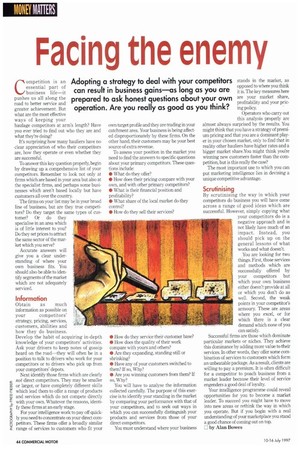Facing the enemy
Page 46

If you've noticed an error in this article please click here to report it so we can fix it.
Competition is an essential part of business life—it pushes us all along the road to better service and greater achievement. But what are the most effective ways of keeping your haulage competitors at arm's length? Have you ever tried to find out who they are and what they're doing?
It's surprising how many hauliers have no clear appreciation of who their competitors are, how they operate or even whether they are successful.
To answer this key question properly, begin by drawing up a comprehensive list of your competitors. Remember to look not only at firms which are based in your area but also at the specialist firms, and perhaps some businesses which aren't based locally but have customers all over the country.
Accurate answers will give you a clear understanding of where your own business fits. You should also be able to identify segments of the market which are not adequately serviced.
Information
Obtain as much information as possible on your competitors' strategy, pricing, services, customers, abilities and how they do business. Develop the habit of acquiring in-depth knowledge of your competitors' activities. Ask your drivers to keep notes of gossip heard on the road—they will often be in a position to talk to drivers who work for your competitors or to drivers who pick up from your competitors' depots.
Next identify those firms which are clearly
• not direct competitors, They may be smaller Leti or larger, or have completely different skills Lr_ which lead them to offer a range of products 13 and services which do not compete directly E • with your own. Whatever the reasons, identi
fy these firms at an early stage.
1For your intelligence work to pay off quick • ly you need to concentrate on your direct corn° 5 petitors. These firms offer a broadly similar range of services to customers who fit your own target profile and they are trading in your catchment area. Your business is being affected disproportionately by these firms. On the other hand, their customers may be your best source of extra revenue.
To assess your position in the market you need to find the answers to specific questions about your primary competitors. These questions include: • What do they offer?
• How does their pricing compare with your own, and with other primary competitors?
• What is their financial position and profitability?
• What share of the local market do they control?
• How do they sell their services?
• How do they service their customer base?
• How does the quality of their work compare with yours and others?
• Are they expanding, standing still or shrinking?
• Have any of your customers switched to them? If so, Why?
• Are you winning customers from them? If so, Why?
You will have to analyse the information collected carefully. The purpose of this exercise is to identify your standing in the market by comparing your performance with that of your competitors, and to seek out ways in which you can successfully distinguish your products and services from those of your direct competitors.
You must understand where your business stands in the market, as opposed to where you think it is. The key measures here are your market share, profitability and your pricing policy.
Operators who carry out this analysis properly are almost always surprised by the results. You might think that you have a strategy of premium pricing and that you are a dominant player in your chosen market, only to find that in reality other hauliers have higher rates and a bigger market share.You might think you're winning new customers faster than the competition, but is this really the case?
The most important use to which you can put marketing intelligence lies in devising a unique competitive advantage.
By scrutinising the way in which your competitors do business you will have come across a range of good ideas which are successful. However, simply copying what your competitors do is a negative approach and is not likely have much of an impact. Instead, you should pick up on the general lessons of what works and what doesn't.
You are looking for two things. First, those services and methods which are successfully offered by your competitors but which your own business either doesn't provide at all or which you don't do as well. Second, the weak points in your competitor's armoury. These are areas where you excel, or for which there is a clear demand which none of you can satisfy.
Successful firms are those which dominate particular markets or niches. They achieve this dominance by adding more value to their services. In other words, they offer some combination of services to customers which form an unbeatable package. As a result, clients are willing to pay a premium. It is often difficult for a competitor to poach business from a market leader because their level of service engenders a good deal of loyalty.
Your intelligence programme could reveal opportunities for you to become a market leader. To succeed you might have to move into new areas or rethink the way in which you operate. But if you begin with a real understanding of your marketplace you stand a good chance of coming out on top.
E by Alan Bowes








































































































